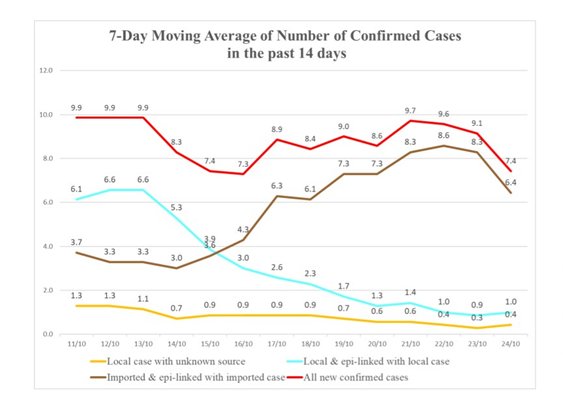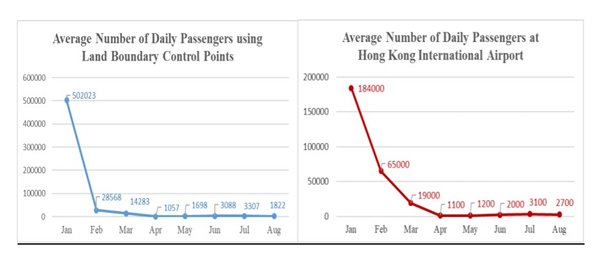Epidemic controlled with precision
Chief Executive Carrie Lam
Over the past month, the global epidemic situation has shown no sign of abating, with the number of daily confirmed cases setting new records again (eg the number of daily confirmed cases worldwide exceeded 400,000 for the first time on October 16). Some places had to once again resort to extreme social distancing measures, such as ordering the closure of restaurants and most shops. In Hong Kong, the epidemic situation has been generally stable. This has not only given us some breathing space, but also allowed us to take more precise control measures and resume more economic and social activities gradually while keeping the epidemic in check.
How the epidemic has developed
In the past month, the number of daily confirmed cases hovered between single and low double digits. From September 25 to October 24, a total of 233 cases were recorded, with over 60% being imported cases which were confirmed under the test and hold arrangement upon arrival to Hong Kong or during the 14-day compulsory quarantine and did not enter the community. As for local confirmed cases, cases of unknown sources were reported on 10 consecutive days (from September 30 to October 9), and the associated infection clusters involved Thai people, a residential care home for people with disabilities, a hotel and a bar. We were extremely concerned about a rebound of the epidemic situation and responded with targeted measures. In the past two weeks (from October 11 to October 24), there were still local cases of unknown sources (although no such cases were reported for seven days), indicating that the transmission chains have yet to be cut off in the community. One local case of unknown source is one case too many. Moreover, as the virus may be more active in autumn and winter, the whole community has to remain vigilant.
Anti-epidemic efforts
To prevent a rapid rebound of the epidemic situation as seen in some countries in Western Europe, the Government has been more cautious in relaxing social distancing measures compared to May and June after the second wave of the epidemic. We cannot let our guard down, especially after many people went out and gathered during the National Day and Mid-Autumn Festival long holidays and the increase in cases we have seen in early October. Therefore, we have not relaxed social distancing measures by a large extent over the past month, but instead adopted a more precise approach to respond to the situation with a view to minimising the impact on society while making efforts to combat the epidemic. The major measures introduced are set out below chronologically:
|
Date |
Event |
|
September 28 |
The Finance Committee of the Legislative Council approved the third round of the Anti-epidemic Fund and other related measures costing a total amount of $24 billion. |
|
September 29 |
Face-to-face classes in all schools in Hong Kong were fully resumed. |
|
October 9 |
The Hospital Authority extended the distribution time of specimen collection packs in 46 general outpatient clinics. |
|
October 9 |
The expansion of the community treatment facility at AsiaWorld-Expo supported by the central government was completed and handed over to the Hospital Authority for future use. |
|
October 9 |
The Food & Environmental Hygiene Department (FEHD) arranged a mobile van to deliver specimen bottles to bar areas for three consecutive nights to encourage staff in bars or pubs and their patrons to undergo free virus testing. In view of confirmed cases involving Thai people, the Department of Health arranged free virus testing service for Thai residents in Kowloon City District. |
|
October 10 |
The Government set up temporary testing centres in Wan Chai, Kwai Tsing, Kowloon City and Yau Tsim Mong districts, which were related to community outbreak clusters. A total of 16,802 people used the free testing service. |
|
October 14 |
Hong Kong and Singapore reached an in-principle agreement to establish a bilateral Air Travel Bubble. |
|
October |
The United Kingdom, France and Russia were included as specified high-risk places along with 10 other places. An inbound traveller who has been in any of these places within 14 days must show proof of a negative virus test result and confirmed room reservation in a hotel in Hong Kong for the 14-day compulsory quarantine before boarding an aircraft to Hong Kong. |
|
October |
While social distancing measures were largely maintained with seven days as a cycle, the scope of the exempted group gatherings was expanded to cover religious activities, weddings, shareholders or corporate meetings and local group tours where the prohibition on group gatherings of more than four people did not apply. Some team sports activities were allowed to resume. |
Staying vigilant and planning ahead
While it is difficult to completely eliminate the risk of virus transmission before the advent and widespread application of effective vaccines, the Hong Kong Special Administrative Region Government will continue to do all it can to get prepared for the fight against the virus. This includes:
- further enhancing the virus testing capacity and trying to lower the testing fees under the Government’s lead and through market forces;
- providing free testing services for targeted groups, including people working in high-risk and high-exposure sectors and staff of critical infrastructure or services;
- applying information technology to enhance efficiency in contact tracing;
- completing the construction of Phase 3 and Phase 4 of the Penny’s Bay Quarantine Centre to provide an additional 2,000 quarantine units, bringing the total number of quarantine units provided by all quarantine centres to over 4,000;
- co-operating with the project team commissioned by the central government to complete the construction of a temporary hospital which will provide negative pressure wards that can accommodate 800 beds; and
- pressing ahead with vaccine procurement under a two-pronged strategy to safeguard public health.
Working together to relaunch the economy
The ongoing epidemic, which has lasted for nine months, has caused a global economic downturn and many industries in Hong Kong have been hard hit. Take a look at the plunge in the number of land and air passengers in the second chart and you will see the severe blow the epidemic has caused to the aviation, tourism and other related industries.
To strive for recovery, relevant trades and organisations have been working hard to comply with the Government’s anti-epidemic measures. For example:
- To prepare for the return of tourists, the Hong Kong Tourism Board and the Hong Kong Quality Assurance Agency have jointly launched a standardised hygiene protocol to help tourists better understand the measures in place across tourism-related industries (covering shopping malls, hotels, restaurants, retail outlets, coach companies, major attractions and tour operators, etc).
- At present, more than 1,800 companies and shops have expressed interest in adopting the protocol;
- With the relaxation of the number of people allowed in local group tours to 30, the Travel Industry Council of Hong Kong will assume a monitoring role to ensure that travel agents implement the relevant measures. The council will also arrange a free virus test for tour guides and escorts.
- The bar industry has voluntarily implemented a number of epidemic control measures since resuming businesses, including the signing of an anti-epidemic charter by several hundred bars pledging to require customers to fill in electronic health declaration forms, install air disinfection devices, sterilise utensils, etc.
In addition, the Government will spare no effort to help businesses continue to operate and provide services during the epidemic. Launched in May, the Distance Business Programme has approved more than 17,000 applications involving subsidies of some $970 million. Applications for the Programme will close on October 31. Businesses in need are encouraged to submit their applications. Furthermore, the Subsidy Scheme for Promotion of Contactless Payment in Public Markets implemented by the FEHD is also open for application.
Conclusion
In the face of a weak economy and the rapid deterioration of the employment situation, the Hong Kong SAR Government will continue to fight the long battle against the virus as well as take multi-pronged measures to preserve the economy.
Chief Executive Carrie Lam issued this article titled Fighting the Virus for Nine Months Controlling the Epidemic with Precision on October 25.

